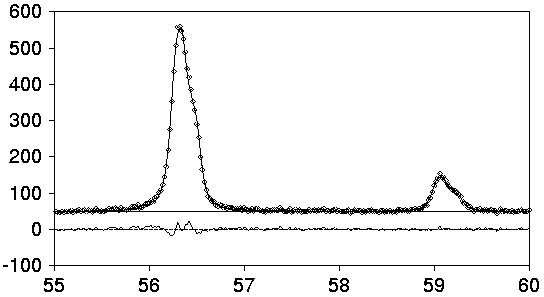Here, we want to explain the new feature Learnt Profiles.
It is available starting with level 3.0.0 of the BGMN & related
program suite. Therefore, a new program VERZERR was added. VERZERR
deconvolutes some standard specimen profiles and delivers the
geometric part G of the
three-fold convolution giving the
whole measured profile. The output of VERZERR is fully compatible to
the output of GEOMET. It uses identic parametrization given in a
*.ger file similar to those produced by GEOMET. Therefore,
this file can posprocessed by MAKEGEQ (delivering a *.geq
file) and used by BGMN & related programs in an identic manner.
For using Learnt Profiles with BGMN & related programs,
you must therefore do two preparations:
- Preparation of some standard specimen &
analysis of residual line widths
- Measurement of some standard lines &
deconvolution using VERZERR
Please follow the above links!
The CeO2 from NIST SRM 674a reference material was chosen for
the test because of the high linear attenuation coefficient (like the
standard material Y2O3). Scans were performed at
angular range 20-125 deg, step size 0.02 deg, counting
time 10 s per step on both the XRD 3000 TT diffractometer
(using raytraced & tube-tails corrected FPA profiles) and the
D 5000 diffractometer (using learnt profiles). Here are the results:

Partial angular range of the D 5000 Rietveld plot
| Device | XRD 3000 TT |
D 5000 |
| G type | raytraced |
learnt profiles |
| Rwp | 8.00% |
4.80% |
| Rexp | 7.15% |
4.03% |
| size | 1947(13)Å |
1995(25)Å |
| microstrain | 0.0137(10)% |
0 (on boundary) |
Comparison of both the raytraced FPA and the learnt profiles results
The mean crystallite size calculated from both methods agree within
3σ. Obviously, the much larger FWHM of the
D 5000 precludes the detection of the small microstrain.








